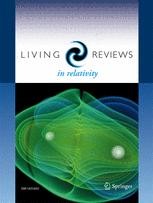Living Reviews in Relativity: "Terrestrial gravity fluctuations" (Update)
 Harms, J., "Terrestrial gravity fluctuations", Living Rev Relativ (2019) 22: 6. https://doi.org/10.1007/s41114-019-0022-2
Harms, J., "Terrestrial gravity fluctuations", Living Rev Relativ (2019) 22: 6. https://doi.org/10.1007/s41114-019-0022-2
Open Access | Review Article
First Online: 14 October 2019
Major revision, updated and expanded version of
https://doi.org/10.1007/lrr-2015-3.
"The updated version of the article "Terrestrial Gravity Fluctuations" by Harms provides an excellent overview of the topic. The article is really well written, shows superb use of languange and attention to detail. The author is probably the most knowledgable and most active expert on this topic worldwide, so there is no doubt that the overall selection and presentation of the material is very good. Overall the quality of the article is outstanding!"
Abstract:
Terrestrial gravity fluctuations are a target of scientific studies in a variety of fields within geophysics and fundamental-physics experiments involving gravity such as the observation of gravitational waves. In geophysics, these fluctuations are typically considered as signal that carries information about processes such as fault ruptures and atmospheric density perturbations. In fundamental-physics experiments, it appears as environmental noise, which needs to be avoided or mitigated. This article reviews the current state-of-the-art of modeling high-frequency terrestrial gravity fluctuations and of gravity-noise mitigation strategies. It hereby focuses on frequencies above about 50 mHz, which allows us to simplify models of atmospheric gravity perturbations (beyond Brunt–Väisälä regime) and it guarantees as well that gravitational forces on elastic media can be treated as perturbation. Extensive studies have been carried out over the past two decades to model contributions from seismic and atmospheric fields especially by the gravitational-wave community. While terrestrial gravity fluctuations above 50 mHz have not been observed conclusively yet, sensitivity of instruments for geophysical observations and of gravitational-wave detectors is improving, and we can expect first observations in the coming years. The next challenges include the design of gravity-noise mitigation systems to be implemented in current gravitational-wave detectors, and further improvement of models for future gravitational-wave detectors where terrestrial gravity noise will play a more important role. Also, many aspects of the recent proposition to use a new generation of gravity sensors to improve real-time earthquake early-warning systems still require detailed analyses.
Changes:
1) Abstract and Introduction revised. 2) Sect. 2 revised (deleting parts, and rewriting 2.1.3). 3) Sect. 4 completely revised also with a new Fig. 23, and some old figures deleted. 4) Introduction to Sect. 5 rewritten, and also 5.5 and 5.6 modified with new plots in Fig. 30. 5) Sect. 7 revised (especially, 7.1.2, 7.1.3, 7.2.2). Mostly modifying text to discuss results from new citations. Also, old plot in (now) Fig. 49 was substituted by new plots taken from other publication. 36 new references have been added.
The Author:
Jan Harms is Assistant Professor at the Gran Sasso Science Institute. He is chair of the Virgo Newtonian-noise working group with the task to develop systems to mitigate terrestrial gravity noise. His main research focus has been to conceive and to investigate technologies that will lead to sensitivity improvements in future gravitational-wave detectors, which includes the characterization of alternative detector concepts. This requires improving our understanding of fields such as quantum optics, thermodynamics, terrestrial gravity, and methods such as machine learning and modern data-analysis techniques.
